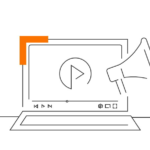These days it’s very difficult to find a competitive advantage, let alone a long term, strategic one. Business is just that competitive. Beyond technical innovation that require huge amounts of R&D, what can you do? Its not an easy question to answer.
I often ask a client to make a list of the things that make them unique, I usually hear “our people, our service, our pricing”. The thing is, if I were to ask their competitors to make the same list, I will get the same answers – not much of an advantage then, are they?
Interestingly, presentations can actually give you a competitive advantage. If you are presenting to your clients with a data heavy, text heavy presentation that is full of facts, you are missing out on a big opportunity. We’ve all sat though these and if you have had to sit through several of these in a row, it is hard to remember who said what… and people can’t make decisions on what they can’t remember.
A strongly branded presentation, one that focuses on the “why” (most just talk about the what, when, where, etc ) and tells a story, will give you a competitive advantage simply because other people aren’t doing it.
Here are some tips:
Brand Strongly
Being strongly branded is far more than just the logo in a corner and in the company colours… it needs to reflect the brand personality and definitely should be more than bullet points. In fact, the more bullet points you have, the less likely it is to be effective. (Saying that, slides that only have pictures are usually equally ineffective.)
A presentation that is truly well branded will definitely help you stand out and have your presentation remembered because it won’t look like anyone else’s. If you can put your competitor’s logo on your presentation and it doesn’t look really out of place, you have a problem. (Try it… send it to someone and see if they notice)
People need to buy the why before they will buy the what!
People need to buy the why before they will buy the what, the where, the when and the who. If telling people facts made a difference, all we would have to do to fix all our health problems is tell people who lead unhealthy lifestyles all the facts and our enormous health bill would be halved. Nobody does anything because of the data or the facts.
Want to know if your presentation is fact rather than why based?
Look at the slide titles. If they are short one or two word titles like “Market Share”, “Financial Performance”, “Our Office Locations”, “Our Clients” or the like, you suffer from an internally facing presentation that deals with data rather than the why.
You need to have a story
It needs to have a story, a direction. You hear a lot about stories in business these days, how they are the new panacea to every communication issue you face… but what does that mean?
Some would have you believe all sorts of things but it’s really quite simple, but it will take practice to do it well.
Try this: Review your presentation and write one short sentence (Max 15 words) about each slide. It should build on what was said in the previous sentence, advancing the narrative and it should be about what it’s in it for the audience. (ie its not “this is where we operate” but “we can serve your offices worldwide”).
Then, sit in front of a colleague or friend and read those sentences to them, without using the slides.
- Does it make sense?
- Does it tell a story that they can follow?
- Does one sentence follow on from the previous and move the presentation towards an outcome?
My guess is it won’t and if it doesn’t, you need to reconstruct your presentation, thinking about the journey you are taking your audience on.
Do not start with ABOUT US
Oh, and one final thing: DO NOT START WITH “ABOUT US” or anything that tells the audience about your company, your clients, your projects or anything else about you.
Apart from a very brief introduction of yourself, the speaker (and don’t have slides for that), that bit can come at the end when they want to know if you have the capabilities to deliver.
Give them a reason to listen to you, what’s in it for them. Tell them the benefits of giving you their time today, how you can help them with their goals or ease their pain points. Nobody wants to hear somebody talk for 10 minutes on themselves until they understand the benefits of why that is important.
Talk credibility not capability.
There are a lot of things you can do to gain a competitive advantage that don’t require years and millions of dollars. Sometimes It can be as simple as building a really powerful sales presentation.




